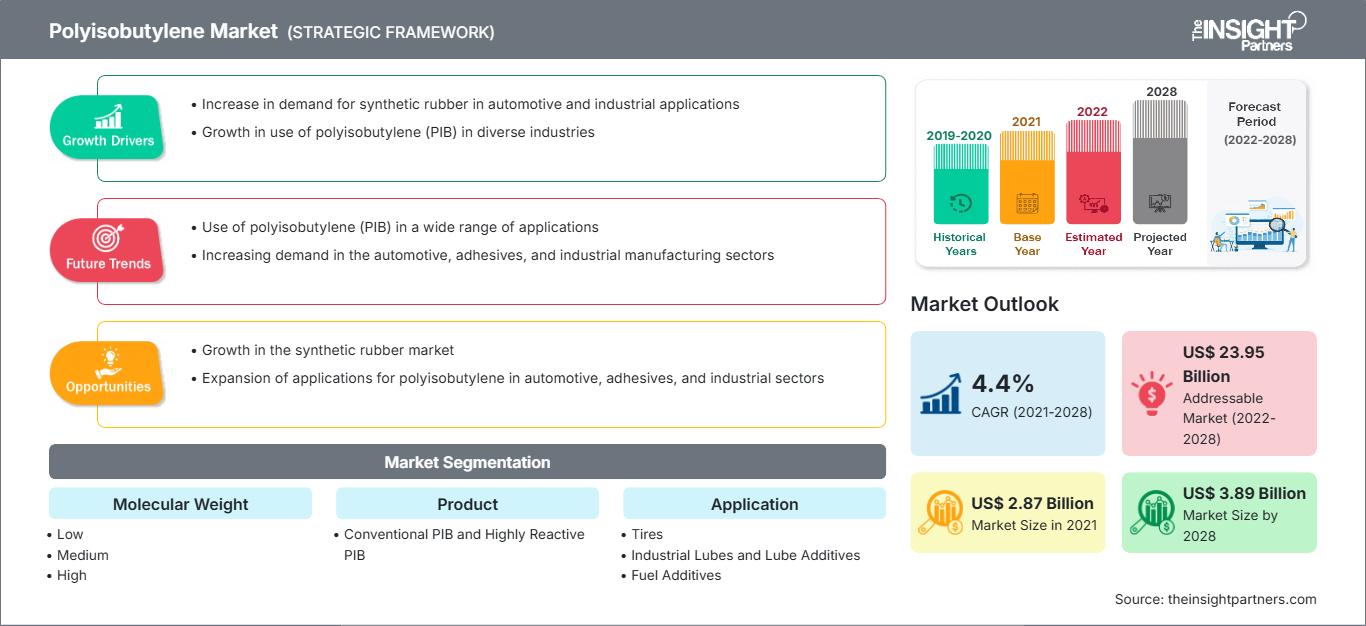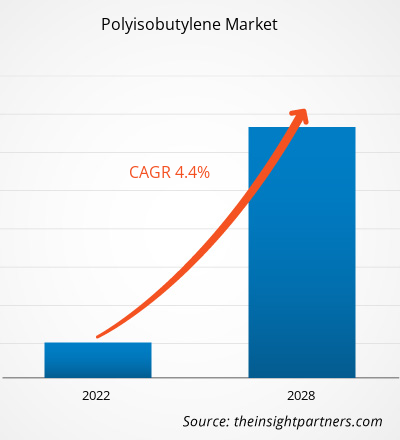[Rapporto di ricerca]Il mercato del poliisobutilene è stato valutato a 2.871,14 milioni di dollari nel 2021 e si prevede che raggiungerà i 3.891,16 milioni di dollari entro il 2028; si prevede una crescita a un CAGR del 4,4% dal 2021 al 2028.
Il poliisobutilene (PIB) è un elastomero o una gomma sintetica. In base al peso molecolare, il mercato è segmentato in basso, medio e alto. È un liquido versatile, non tossico e viscoso come l'acqua. Il poliisobutilene può aumentare l'appiccicosità, fornire idrorepellenza, migliorare l'indice di viscosità e fornire un eccellente isolamento elettrico. Nel 2020, il Nord America ha detenuto la maggiore quota di fatturato del mercato globale del poliisobutilene. La crescente domanda da parte di varie applicazioni, come trasporti, agrochimica, elettricità e adesivi, guida la crescita del mercato in Nord America. Il poliisobutilene è sempre più utilizzato nei settori dei trasporti, alimentare ed edile in quanto offre bassa permeabilità ai gas, eccellente resistenza alla trazione, elevata resistenza chimica e maggiore rigidità.
Personalizza questo rapporto in base alle tue esigenze
Potrai personalizzare gratuitamente qualsiasi rapporto, comprese parti di questo rapporto, o analisi a livello di paese, pacchetto dati Excel, oltre a usufruire di grandi offerte e sconti per start-up e università
Mercato del poliisobutilene: Approfondimenti strategici

- Ottieni le principali tendenze chiave del mercato di questo rapporto.Questo campione GRATUITO includerà l'analisi dei dati, che vanno dalle tendenze di mercato alle stime e alle previsioni.
Potrai personalizzare gratuitamente qualsiasi rapporto, comprese parti di questo rapporto, o analisi a livello di paese, pacchetto dati Excel, oltre a usufruire di grandi offerte e sconti per start-up e università
Mercato del poliisobutilene: Approfondimenti strategici

- Ottieni le principali tendenze chiave del mercato di questo rapporto.Questo campione GRATUITO includerà l'analisi dei dati, che vanno dalle tendenze di mercato alle stime e alle previsioni.
Impatto della pandemia di COVID-19 sul mercato del poliisobutilene
La pandemia di COVID-19 ha drasticamente alterato lo stato del settore chimico e dei materiali e ha avuto un impatto negativo sulla crescita del mercato del poliisobutilene.
L'industria chimica e dei materiali globale è uno dei principali settori che ha subito gravi interruzioni a causa della pandemia, come interruzioni della catena di approvvigionamento, cancellazioni di eventi tecnologici e chiusure degli uffici. I divieti di viaggio globali imposti da paesi in Europa, Asia e Nord America stanno influenzando le opportunità di collaborazioni e partnership commerciali. Si prevede che tutti questi fattori influenzeranno negativamente l'industria elettronica e chimica e dei materiali, ostacolando la crescita di vari mercati correlati a questi settori. Tuttavia, poiché le economie stanno pianificando di riprendere le proprie attività, si prevede che la domanda di poliisobutilene aumenterà a livello globale. La domanda di poliisobutilene da parte dei settori dei lubrificanti industriali e degli additivi per lubrificanti ha iniziato a crescere con la ripresa delle attività commerciali e la revoca delle misure di lockdown a livello globale. Approfondimenti di mercato: l'industria automobilistica alimenterà la crescita del mercato durante il periodo di previsione
Per l'industria automobilistica, le prestazioni dei motori per svolgere le loro funzioni quotidiane sono importanti. L'industria automobilistica è stata per molti anni il mercato chiave per diversi tipi di additivi per carburante. La quota per le automobili è stata costantemente superiore a quella degli altri segmenti di mercato degli additivi per carburante a causa della mancanza di alternative efficienti ai combustibili fossili e di un'economia in crescita della classe media. L'importanza relativa dell'aviazione per gli additivi per carburante è aumentata negli ultimi anni, aumentando di conseguenza la domanda di poliisobutilene.
Approfondimenti sulle applicazioni
In base all'applicazione, il mercato globale del poliisobutilene è segmentato in pneumatici, lubrificanti industriali e additivi per lubrificanti, additivi per carburante, adesivi e sigillanti e altri. Il segmento dei lubrificanti industriali e degli additivi lubrificanti ha detenuto la quota di mercato maggiore nel 2020. Il poliisobutilene (PIB) reagisce con l'anidride maleica per formare anidride poliisobutenil-succinica (PIBSA), un elemento fondamentale per i disperdenti negli oli lubrificanti e per i detergenti nei carburanti. L'altra sua variante, la poliisobutilene-succinimmide (PIBSI), derivata dal poliisobutilene (PIB), agisce come emulsionante antiossidante nei fluidi solubili per la lavorazione dei metalli e come elemento fondamentale per gli additivi lubrificanti. I PIB bruciano anche in modo più pulito, rendendoli ideali per l'uso in oli per motori a due tempi e applicazioni marine in cui i lubrificanti sono esposti ai gas di blow-by aggressivi dei grandi motori diesel.
BASF SE, Braskem SA, Daelim Industrial Petrochemical Division, Ineos AG, Infineum International Limited., Kothari Petrochemicals., Sibur Holding PJSC, Kemat Polybutenes, The Lubrizol Corporation e TPC Group sono tra i principali attori del mercato globale del poliisobutilene. Gli operatori che operano in questo mercato sono fortemente concentrati sullo sviluppo di prodotti innovativi e di alta qualità per soddisfare le esigenze dei clienti.
PoliisobutileneApprofondimenti regionali sul mercato del poliisobutilene
Le tendenze regionali e i fattori che influenzano il mercato del poliisobutilene durante il periodo di previsione sono stati ampiamente spiegati dagli analisti di The Insight Partners. Questa sezione illustra anche i segmenti e la geografia del mercato del poliisobutilene in Nord America, Europa, Asia-Pacifico, Medio Oriente e Africa, America Meridionale e Centrale.
Ambito del rapporto di mercato del poliisobutilene
| Attributo del rapporto | Dettagli |
|---|---|
| Dimensioni del mercato in 2021 | US$ 2.87 Billion |
| Dimensioni del mercato per 2028 | US$ 3.89 Billion |
| CAGR globale (2021 - 2028) | 4.4% |
| Dati storici | 2019-2020 |
| Periodo di previsione | 2022-2028 |
| Segmenti coperti |
By Peso molecolare
|
| Regioni e paesi coperti | Nord America
|
| Leader di mercato e profili aziendali chiave |
|
Densità degli attori del mercato del poliisobutilene: comprendere il suo impatto sulle dinamiche aziendali
Il mercato del poliisobutilene è in rapida crescita, trainato dalla crescente domanda degli utenti finali dovuta a fattori quali l'evoluzione delle preferenze dei consumatori, i progressi tecnologici e una maggiore consapevolezza dei benefici del prodotto. Con l'aumento della domanda, le aziende stanno ampliando la propria offerta, innovando per soddisfare le esigenze dei consumatori e sfruttando le tendenze emergenti, alimentando ulteriormente la crescita del mercato.

- Ottieni il Mercato del poliisobutilene Panoramica dei principali attori chiave
In evidenza nel rapporto
- Tendenze progressive del settore nel mercato del poliisobutilene per aiutare gli operatori a sviluppare strategie efficaci a lungo termine
- Strategie di crescita aziendale adottate dai mercati sviluppati e in via di sviluppo
- Analisi quantitativa del mercato del poliisobutilene dal 2019 al 2028
- Stima della domanda globale di poliisobutilene
- Analisi delle cinque forze di Porter per illustrare l'efficacia di acquirenti e fornitori che operano nel settore
- Sviluppi recenti per comprendere lo scenario competitivo del mercato
- Tendenze e prospettive di mercato, nonché fattori che guidano e frenano la crescita del mercato del poliisobutilene
- Assistenza nel processo decisionale evidenziando le strategie di mercato che sostengono l'interesse commerciale, portando alla crescita del mercato
- Dimensioni del mercato del poliisobutilene in vari nodi
- Panoramica dettagliata e segmentazione del mercato, nonché le dinamiche del settore del poliisobutilene
- Dimensioni del mercato del poliisobutilene in varie regioni con promettenti opportunità di crescita
Mercato del poliisobutilene
Per peso molecolare
- Basso
- Medio
- Alto
- Prodotto
- PIB convenzionale
- PIB altamente reattivo
Applicazione
- Pneumatici
- Lubrificanti industriali e additivi per lubrificanti
- Additivi per carburante
- Adesivi e sigillanti
- Altri
Industria di utilizzo finale
- Industriale
- Alimentare
- Altri
Profili aziendali
- BASF SE
- Braskem SA
- Divisione petrolchimica industriale Daelim
- Ineos AG
- Infineum International Limited.
- Kemat Polybutenes
- Kothari Petrochemicals
- Sibur Holding PJSC
- The Lubrizol Corporation
- TPC Group
- Analisi storica (2 anni), anno base, previsione (7 anni) con CAGR
- Analisi PEST e SWOT
- Valore/volume delle dimensioni del mercato - Globale, Regionale, Nazionale
- Industria e panorama competitivo
- Set di dati Excel
Report recenti
Testimonianze
Motivo dell'acquisto
- Processo decisionale informato
- Comprensione delle dinamiche di mercato
- Analisi competitiva
- Analisi dei clienti
- Previsioni di mercato
- Mitigazione del rischio
- Pianificazione strategica
- Giustificazione degli investimenti
- Identificazione dei mercati emergenti
- Miglioramento delle strategie di marketing
- Aumento dell'efficienza operativa
- Allineamento alle tendenze normative






















 Ottieni un campione gratuito per - Mercato del poliisobutilene
Ottieni un campione gratuito per - Mercato del poliisobutilene